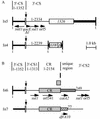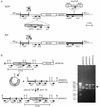In34, a complex In5 family class 1 integron containing orf513 and dfrA10
- PMID: 12499211
- PMCID: PMC149023
- DOI: 10.1128/AAC.47.1.342-349.2003
In34, a complex In5 family class 1 integron containing orf513 and dfrA10
Abstract
A complex class 1 integron, In34, found in a conjugative plasmid from a multidrug-resistant Klebsiella pneumoniae strain isolated in 1997 at a hospital in Sydney, Australia, was shown to have a backbone related to that of In2, which belongs to the In5 family. In In34, the aadB gene cassette replaces the aadA1a cassette in In2, and two additional resistance genes, dfrA10 and aphA1, that are not part of a gene cassette are present. The aphA1 gene is in a Tn4352-like transposon that is located in the tniA gene. The dfrA10 gene lies adjacent to a 2,154-bp DNA segment, known as the common region, that contains an open reading frame predicting a product of 513 amino acids (Orf513). Orf513 is 66 and 55% identical to the products of two further open reading frames that, like the common region, are found adjacent to antibiotic resistance genes. A 27-bp conserved sequence was found at one end of each type of common region. The loss of dfrA10 due to homologous recombination between flanking direct repeats and incorporation of the excised circle by homologous recombination were demonstrated. Part of In34 is identical to the sequenced portion of In7, which is from a multidrug-resistant Escherichia coli strain that had been isolated 19 years earlier in the same hospital. In34 and In7 are in plasmids that contain the same six resistance genes conferring resistance to ampicillin, chloramphenicol, gentamicin, kanamycin, neomycin, tobramycin, trimethoprim, and sulfonamides, but the plasmid backbones appear to be unrelated, suggesting that translocation of a multiple-drug-resistance-determining region as well as horizontal transfer may have occurred.
Figures




Similar articles
-
pCERC3 from a commensal ST95 Escherichia coli: A ColV virulence-multiresistance plasmid carrying a sul3-associated class 1 integron.Plasmid. 2016 Mar-May;84-85:11-9. doi: 10.1016/j.plasmid.2016.02.002. Epub 2016 Feb 18. Plasmid. 2016. PMID: 26855083
-
Complex multiple antibiotic and mercury resistance region derived from the r-det of NR1 (R100).Antimicrob Agents Chemother. 2004 Nov;48(11):4250-5. doi: 10.1128/AAC.48.11.4250-4255.2004. Antimicrob Agents Chemother. 2004. PMID: 15504849 Free PMC article.
-
Sequences of two related multiple antibiotic resistance virulence plasmids sharing a unique IS26-related molecular signature isolated from different Escherichia coli pathotypes from different hosts.PLoS One. 2013 Nov 4;8(11):e78862. doi: 10.1371/journal.pone.0078862. eCollection 2013. PLoS One. 2013. PMID: 24223859 Free PMC article.
-
Transposons related to Tn1696 in IncHI2 plasmids in multiply antibiotic resistant Salmonella enterica serovar Typhimurium from Australian animals.Microb Drug Resist. 2010 Sep;16(3):197-202. doi: 10.1089/mdr.2010.0042. Microb Drug Resist. 2010. PMID: 20701539
-
A novel gene cassette, aacA43, in a plasmid-borne class 1 integron.Antimicrob Agents Chemother. 2011 Jun;55(6):2979-82. doi: 10.1128/AAC.01582-10. Epub 2011 Mar 21. Antimicrob Agents Chemother. 2011. PMID: 21422220 Free PMC article.
Cited by
-
Functional characterization of the ABC transporters and transposable elements of an uncultured Paracoccus sp. recovered from a hydrocarbon-polluted soil metagenome.Folia Microbiol (Praha). 2023 Apr;68(2):299-314. doi: 10.1007/s12223-022-01012-0. Epub 2022 Nov 3. Folia Microbiol (Praha). 2023. PMID: 36329216
-
New structures simultaneously harboring class 1 integron and ISCR1-linked resistance genes in multidrug-resistant Gram-negative bacteria.BMC Microbiol. 2016 Apr 21;16:71. doi: 10.1186/s12866-016-0683-x. BMC Microbiol. 2016. PMID: 27103443 Free PMC article.
-
Antibiotic resistance gene cluster of pAPEC-O1-R.Antimicrob Agents Chemother. 2007 Sep;51(9):3461-2. doi: 10.1128/AAC.00417-07. Epub 2007 Jun 25. Antimicrob Agents Chemother. 2007. PMID: 17591845 Free PMC article. No abstract available.
-
ISCR2, another vehicle for bla(VEB) gene acquisition.Antimicrob Agents Chemother. 2009 Nov;53(11):4940-3. doi: 10.1128/AAC.00414-09. Epub 2009 Aug 24. Antimicrob Agents Chemother. 2009. PMID: 19704129 Free PMC article.
-
Dissemination of multiple drug resistance genes by class 1 integrons in Klebsiella pneumoniae isolates from four countries: a comparative study.Antimicrob Agents Chemother. 2011 Jul;55(7):3140-9. doi: 10.1128/AAC.01529-10. Epub 2011 Apr 25. Antimicrob Agents Chemother. 2011. PMID: 21518841 Free PMC article.
References
-
- Adrian, P. V., K. P. Klugman, and S. G. B. Aymes. 1995. Prevalence of trimethoprim resistant dihydrofolate reductase genes identified with oligonucleotide probes in plasmids from isolates of commensal faecal flora. J. Antimicrob. Chemother. 35:497-508. - PubMed
-
- Boyd, D., G. A. Peters, A. Cloeckaert, K. S. Boumedine, E. Chaslus-Dancla, H. Imberechts, and M. R. Mulvey. 2001. Complete nucleotide sequence of a 43-kilobase genomic island associated with the multidrug resistance region of Salmonella enterica serovar Typhimurium DT104 and its identification in phage type DT120 and serovar Agona. J. Bacteriol. 183:5725-5732. - PMC - PubMed
Publication types
MeSH terms
Substances
LinkOut - more resources
Full Text Sources
Medical

